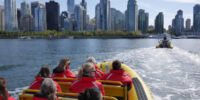Email Marketing Best Practices for Tourism Businesses
Email marketing is one of the most effective—and affordable—digital tools for small and medium-sized tourism businesses in BC. When it’s done well, it helps you stay top of mind with past guests, reach new people, and drive bookings throughout the year.
Unlike social media, where algorithms decide who sees (or doesn’t see) your content, email gives you a direct line to your audience. You control the message. The timing. The ask.
Email also tends to deliver one of the best returns on investment (ROI) among all digital channels. With low costs, steady engagement, and the ability to build genuine relationships with past and future guests, email is one of the easiest ways to stay connected—and stay booked.
This guide outlines 13 up-to-date best practices, each with tourism-specific tips to help your business improve results and inspire action.
1. Know the Email Environment
Understanding how email marketing works is important, not just for getting results, but also to stay on the right side of the rules.
Start with a reliable Email Service Provider (ESP). Most ESPs automatically include key features such as unsubscribe links, contact info, and mobile-friendly design by default, making it easier to stay organized and follow regulations.
In Canada, you must follow Canada’s Anti-Spam Legislation (CASL), which requires:
- Clear consent before emailing someone
- Contact information in every message
- An easy way to unsubscribe
If you serve international travellers, you may also need to follow laws such as the EU’s General Data Protection Regulation (GDPR) or the US Federal Trade Commission’s CAN-SPAM Act. A privacy policy on your website is a must—it helps people understand what you collect, how you use it, and how to reach you if they have questions.
Never buy email lists. It violates privacy laws and can damage your reputation.
To improve your email marketing, keep an eye on what others are doing. Subscribe to a few emails—from both tourism competitors and unrelated industries—and see what lands in your inbox. How often do they send? What kinds of subject lines do they use? What grabs your attention… or doesn’t?
Keep a running list of ideas, even ones you’re not sure about. Hospitality, retail, or lifestyle brands may offer a fresh lens for format or tone. Just keep your voice grounded in your experience, community, or First Nation.

Tourism Tip: Set up a tablet at your front desk or booth so people can sign up in person. Let them know what to expect, such as trip ideas, special offers, or seasonal updates.

Remember: If you out-source the handling of your email marketing to a contractor, you remain 100% legally responsible to comply with the law.
2. Don’t Skip Domain Authentication
If you’re using an email marketing platform like Mailchimp, you’ll need to authenticate your domain to meet new email security rules from Gmail and others. This helps prove you’re a legitimate sender—and makes sure your emails land in inboxes, not spam folders.
Look for these terms in your email provider’s setup guide:
- SPF (Sender Policy Framework): Prevents others from faking emails from your domain.
- DKIM (DomainKeys Identified Mail): Confirms you’re authorized to send from your domain.
- DMARC (Domain-based Message Authentication, Reporting & Conformance): Links everything together and adds protection.

Tourism Tip: Your email platform should be able to walk you through these steps. Here’s an example from Mailchimp to help you get started.
3. Be Consistent
Staying consistent helps build trust. If you only send emails when it’s convenient, people might forget who you are or why they signed up in the first place.
Pick a rhythm that suits your capacity—once a month, every couple of weeks, or aligned with key tourism seasons; Whatever works. Just aim for something steady. It helps your audience know when to expect something from you, and gives you time to prepare something worth sending.
Branded templates can also help with this. A familiar layout, complete with your logo, colours, and tone of voice, makes your emails recognizable—and easier to pull together.

Tourism Tip: Let your email rhythm follow your tourism season. You might send more ahead of busy periods and scale back after. Let people know what kind of content you’ll be sending and how often, so they know what to expect when they subscribe.
4. Create a Welcome Sequence
A welcome sequence is a series of automated emails sent after someone signs up for your email list. It’s a way to introduce your business, build trust, and stay in touch while they’re still curious.
You don’t need anything fancy. A simple three-part series works well:
- Email 1: Welcome + What to Expect – Send immediately after sign-up. Thank them, deliver what you promised (like a guide or offer), and say a little (2-3 sentences) about who you are. Let them know what you’ll be sharing and how often they’ll hear from you.
- Email 2: Add Something Useful – Two to four days after your welcome email, send a planning tip, blog post, or small discount to give them a reason to stay interested.
- Email 3: Invite a Next Step – Five to seven days following Email 2, suggest they follow you on social media, check out an experience, or reach out. Keep it casual and easy to act on.
Once they’ve seen your welcome series, move them over to your regular list.

Tourism Tip: Add a strong visual to the first email that shows what you’re all about—maybe a scenic photo, a short video, or even a fun behind-the-scenes clip.
5. Segment Your List
Segmenting means organizing your subscriber list into groups, so people get emails that make sense to them.
It works. Segmented emails often perform better than one-size-fits-all blasts.
You can group subscriber your list by:
- New vs. returning guests
- Local, regional, or international visitors
- Summer vs. winter travellers
- Family trips vs. solo or couples
- Activity level or interest
Most ESPs make this easy with tags or custom fields. Tags are labels you apply to subscribers based on their behaviour or interests. For example, you might tag someone as “SummerTraveller,” “PastGuest,” or “FamilyTrip.” You can add multiple tags to the same subscriber and use them to send targeted emails.
Custom fields are specific pieces of information that you collect, such as a subscriber’s first name, home city, or preferred activity. These let you personalize emails (e.g., “Hi Alex, ready for your next hike near Fernie?”) or create segments based on shared data.
Over time, you’ll spot which segments book the most, which will help you focus your efforts where they count.

Tourism Tip: Reach out to last year’s guests with a friendly “Hope to see you again” note. Add a new offer or seasonal hook. A familiar name might be all they need to click.
6. Test Regularly
Testing helps you understand what works, rather than just hoping it lands.
Try A/B testing, which means sending two versions of an email to a small group (maybe with different subject lines or images). See which email performs better (has higher open rates, gets readers to click on a link, etc.), then send that version to the rest of your list. Most ESPs support this.
You can also test your welcome emails over time. Small changes can add up.
Try testing:
- Subject lines
- Call to Action (CTA) buttons
- Layouts or images
- Send times
Always preview emails on mobile, and check Dark Mode too—some formatting can look strange when colours are inverted.

Tourism Tip: Try one lighthearted subject line and one straightforward one. See which one people open. Then use that style again next time.
7. Include a Primary Call to Action (CTA)
Every email should have one main thing you want people to do. Not three. One.
If you have multiple messages or offers, consider sending them to different segments of your list—or save one for a future email. Keeping each message focused improves clarity and results.
That might be “Book now,” “Get your guide,” or “Start planning.” If there are too many options, people tend to do… nothing.
Use buttons, bold text, or obvious links—especially for phones. Keep it clean and clear.

Tourism Tip: Instead of vague phrases like “Learn more,” try “Book your fall escape” or “Plan your snowshoe tour.” Specific and timely works better. (“Learn more” tends to work better on social media marketing when a campaign is designed to pique interest.)
8. Personalize Your Emails
Personalized emails almost always perform better than generic ones.
Start by using name tags in your email service provider (ESP)—these pull in the subscriber’s first name automatically. Add it to the subject line or greeting for a friendly, personal touch.
You can also use merge tags to go further. Merge tags are placeholders that let you insert other personal details, like a subscriber’s city, interests, or recent activity (e.g., if they downloaded a hiking guide or clicked a fishing tour).
Follow up with something relevant. A note like, “Still thinking about that backcountry route?” feels more human—and more memorable.
These little touches build trust. And make you harder to forget.

Tourism Tip: Add a short, friendly message based on what they last viewed: “Hope the trails are treating you well, Alex.” Most ESPs make this easy with merge tags, which automatically fill in names or other custom info like trip type or location.
9. Clean Your List
A clean list isn’t just tidy—it performs better.
That means periodically clearing out emails that bounce, and letting go of people who haven’t opened or clicked in the last year.
Why it matters:
- Better deliverability
- Fewer spam complaints
- More accurate results
- Higher open, click-through and conversion rates (OR, CTR, and CR respectively)
Steps:
- Find inactive subscribers
- Send a re-engagement email
- Remove the ones who don’t respond
Some ESPs also let you add a logo to inbox previews using Brand Indicators for Message Identification (BIMI). This isn’t essential, but it can make your brand feel more familiar at a glance.

Tourism Tip: Once a year, send a kind, simple email, like “Still want to hear from us?” Let people stay, update their preferences, or unsubscribe. You only want the people who want to be there.
10. Review Results
Checking your numbers helps you figure out what’s working—and what to skip next time.
Key metrics to monitor:
A few things to watch:
- Click-through rate (CTR): Who clicked something?
- Conversions: Who followed through (booked, downloaded, etc.)?
- Unsubscribes: A few are fine. Spikes mean something’s off.
- Bounce rate: Emails that didn’t reach inboxes.
- Inbox placement: If you’re landing in spam a lot, that’s a problem – Dig into this further.
Keep up to date on current email marketing benchmarks in tourism to help you understand how your emails are performing. Then, set small, clear goals, like “get 10% more clicks.” Then look back once a month. Over time, you’ll see patterns.

Tourism Tip: Add tracking links to your buttons. You’ll know which content got the most action, so you can double down on what worked.
11. Make Emails Mobile-First Design
Most people check email on their phones. Often, while distracted. You’ve got a few seconds.
So your emails need to load fast, look good, and make sense right away.
Try:
- Short paragraphs
- Big, easy-to-tap buttons
- Clear sections with bold headings
- Plenty of space between parts
And always test it on your own phone. Or a few phones, if possible, on dark mode and otherwise.

Tourism Tip: Think of your email like a rack card—but on a phone. Can someone understand it in 10 seconds and act on it? If not, trim it down.
12. Automate More with Less Effort
Automation doesn’t need to be complicated. A few basic automations can save a lot of time, especially for small teams.
Set it up once, and let it run in the background:
- “Thanks for booking” emails
- “You left something in your cart” nudges
- “Time to plan your summer getaway?” reminders
- Post-trip thank-yous or review requests
Most ESPs offer simple tools for this purpose. Even just one or two automations can make you feel more responsive, without being glued to your laptop.

Tourism Tip: Set up an auto-reminder for anyone who starts booking but doesn’t finish. A short note might be all they need to come back.
13. Respectful Use of AI Tools
AI tools like ChatGPT or Jasper can help brainstorm or draft, but they’re not a replacement for your voice or judgment.
AI can help:
- Draft subject lines or headlines
- Generate content ideas
- Suggest send times or structure
But it can’t replace your judgment, your brand voice, or the responsibility you hold in representing people, places, and experiences accurately.
Use AI to support your work, not replace your voice. Always check the content for accuracy, tone, and cultural relevance, especially when your emails highlight place-based experiences or mention Indigenous or local communities you’re not a part of. When in doubt, consult or collaborate directly with the relevant parties.
Also think critically about:
- Is this content accurate, up-to-date, and suitable for our audience?
- Am I reflecting the people, cultures, or regions involved with care, permission, and context?
- Does this sound like us, and reflect our values and commitments?
Tourism content carries meaning. Missteps—like generic messaging, cultural inaccuracies, or tone that doesn’t align—can erode trust and damage relationships.

Tourism Tip: Use AI to brainstorm ideas or draft options—but always review, refine, or rewrite to ensure the content is true to your brand, appropriate for your audience, and respectful of the people and places it represents.
Effective email marketing doesn’t have to be complicated. By applying these tips— and having a clear sense of who you’re talking to—it can become a natural part of how you connect with travellers.
Focus on being timely, useful, and real. Emails don’t need to be perfect; They just need to land with intention. The more your emails reflect your voice, your place, and your values, the more likely they are to stick.
Digital tools and platforms used in tourism marketing evolve quickly. Features, algorithms, interfaces, AI and even how travellers find or engage with your content may change over time. This article is designed to stay relevant for tourism businesses in BC, but processes, settings, and terminology can shift. For the most accurate and current information, always check the official documentation or help pages of the tools and platforms you use to share, advertise, or manage your tourism business online.





